 People who don’t run will see this picture of me with a tire drag and wonder what the hell I’m doing. But if you’re a runner, I bet you recognize this contraption and have wondered how to set one up for yourself.
People who don’t run will see this picture of me with a tire drag and wonder what the hell I’m doing. But if you’re a runner, I bet you recognize this contraption and have wondered how to set one up for yourself.
Good thinking. I’ve used this training method for years, including 1.5-hour road drags in preparation for my run across America. Using a tire drag is the best form of sport-specific cross-training a runner can do. When you pull a tire, you change the points of resistance and load on your body, and you train your muscles in a way that’s slightly different from your regular running gait.
The key is the light to medium resistance on your mid-section that you get from pulling the tire, something like a husky hauls a sled.
By doing this, you get core and strength training while you run, along with the bonus of entraining your mind with your body as you put one foot in front of the other. In other words, your body and mind work constantly to make micro changes in your gait, working together to keep you upright and moving forward in an unbalanced situation.
Tire Drag: Major Benefits
- It’s better than “regular” running: it’s lower impact, requires you to run upright, recruits muscles you don’t normally use, and more intensely works out your calves, quads, and upper body.
- The tire drag targets some of the hard-to-tone muscles like abs and glutes. Nothing like it for the stomach and butt!
- Pulling a tire trains you to run using the midsection. After training this way, you’ll run from your core even when you aren’t pulling the tire.
- You’ll improve your form, especially if you pay attention and concentrate on that (see “How to Train Pulling the Tire” below).
- Using a tire drag simulates running hills, which is especially helpful if you live in a flat place but need to train for a hilly course.
- You’ll strengthen your knees and improve overall balance.
Ready to go? Gather up these parts and get started …
What You’ll Need to Make Your Tire Drag
Old tire. Any brand, 13-, 14-, or 15-inch rim diameter. The bigger you are, the bigger the tire. Source: any junk yard.
Leather weight belt. Choose one that’s wide, 3 to 4 inches on the back, with some padding. Make sure it’s a comfortable fit for you. Source: sporting goods store.
Nylon cord or rope. The cord should be 1/4 to 3/8 inches in diameter. You’ll need two pieces, one about 12 inches long, and another one about 8 feet long. Source: hardware store.
Stiff bungee cord. This should be hard to expand and 48 inches long, with carabiners on each end. Source: hardware store.
Phillips screwdriver or drill. You need something capable of getting through the weight belt padding and the tire. source: hardware store.
How to Assemble Your Tire Drag
1. Punch a hole through the weight belt in the back, through the padding on the top and bottom, and thread the cord behind the padding. Loop it around the back of the belt and tie securely, leaving an inch slack or gap between the back of the belt and the cord.
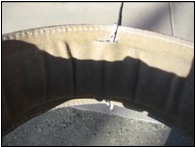
2. Attach the bungee cord to the rope on the weight belt using the carabiner.
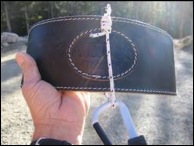
3. Attach another piece of nylon cord or rope to the other end of the bungee cord by making a loop in the cord and attaching it to the carabiner.
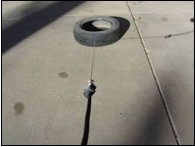
4. Drill a hole in the center of the tire that’s just big enough for the cord to be punched through with a Phillips screwdriver or something similar.
5. Thread the cord through a quarter-inch washer and then tie a double or triple knot (one on top of the other), big enough so it won’t pull back through the hole in the tire.
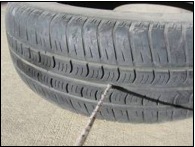

That’s it! Now you’re ready to pull!
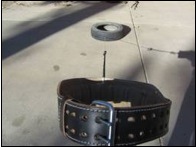
Where to Train With a Tire Drag
A gravel road usually provides the least resistance, a concrete bike path more resistance, and somewhat rough asphalt provides the most resistance. You can use any of these surfaces for your training, depending on how hard you want your workout to be. (Trails aren’t appropriate for pulling a tire.)
On the flat, you can pull the tire to increase the benefit of Fartlek or interval training.
On hills, pull hard going up to develop your glutes and calves, and run at a brisk pace going down to develop your quads or take an easier pace on the downhill for recovery.
How to Train With a Tire Drag
Choose the appropriate location (surface, grade) depending on the goals of your workout.
Secure the weight belt in a comfortable position and place the tire behind you.
Pull from your midsection in a purposeful manner. Envision a string drawing you forward from your navel.
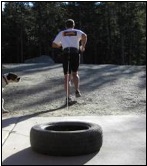
Stay upright and with your shoulders back to open the chest and airways, and keep your chin up and your eyes looking forward down the road.
Pump with your arms bent at a 90-degree angle.

Lift your legs high. Use a shorter stride for form, or a longer stride for power.
Start training by pulling the tire one-half mile.
Increase distance by 1/4 to 1/2 mile in one to two-week increments until the pulling distance is 3 to 6 miles, or about 45 minutes to 1.5 hours if you’re training for a marathon or working to get in optimum shape.
You can run longer distances/times pulling the tire if you’re training for races longer than a marathon.
How Often to Train With a Tire Drag
- Once a week while you’re in training.
- Not at all if you feel a muscle starting to pull. Muscles should tighten up, but not to the point of pain.
Happy Tire Pulling!
Sure, it’s a “drag” … but you can have fun with it. Enjoy!










what doing this tire drag at the beach? Would that be advisable? what about pulling a 5kg or more sack with sand or gravel at the beach?.
Hey, a 5kg sack of sand would work fine, as long as it is durable. The reason I suggest tires is that they are durable and you can get any size you want. A smaller size such as a 13” might be just the ticket for the beach. My wife, Heather, brought up a good point: check with local authorities to make sure this is acceptable to do on the beach, as you don’t want to do any damage to the terrain.
No because grass will cause extra friction to be applied to the tire, thus causing the workout to be more efficent. Sand wouldn’t give you the best results base on their lack of friction.
Hey Marshall,
I did a search to buy one of these premade. But you make it so easy, that I’ll just make one. My weekly mileage is 70 miles and light hills of Connecticut. What kind of mileage should I start out with? And is the first time going to make me very sore?
Thanks for the awesome article.
Hey, Croix, I’m so sorry it has taken me so long to get back to you.
If your weekly mileage is 70, you have a base that you can spring into, say, a 100 miler easily by making sure you have long runs in of 25 miles (or more). At least three of them over a period of two to three months prior to your big event. Yes it is likely you will be sore, but you can minimize the soreness by making sure you are hydrated and eating small bits and pieces along the way. Basic rule of thumb is that on a weekly basis, incorporate a day of core training/weights, one day of speed work, one day of a long run, and if you can a trail run with hills (or on road if you don’t have trails). Then make sure you have at least one day of rest, usually after the long run. I subscribe to two shorter runs back to back instead of a really long run, for instance a 15-miler followed by a 20-miler back to back…it allows you to recover.
whats the average life span of the tire when its being dragged?
I’ve never heard of one of these wearing out, so I would say a lifetime. 🙂
I have had some great workouts towing in the winter through snow with a plastic snow scoop(with the handle removed and replaced with 12′ of rope) with 25-35lb weights secured by a carabiner to the rope in the scoop/’sleigh’ to a weight belt around my waist. Depending on terrain or snow depth I will use my xc ski poles and will bound getting a full-body kinetic chain workout. In the the Spring to Fall I will simply drag 10-25lb weight plates attached with a carabiner (no ‘sled) to my rope and weight belt.Again, when needed ,I willuse my xc poles. The coefficient of friction is high, the resistance can be unpredictable and therefore a good neural challenge. Workout types and duration vary from “endurance” with a lighter weight plate to hills, intervals,fartlek and circuit training with appropriate weght plate resistance.This trainingis all done off-road.
Hi Marshall,
Thanks for the great article! I’m looking into buying the necessary parts but I’m having trouble locating a good weight belt. No fitness store near me has any in stock so I might have to order online. I’d like to get a good, comfortable one…do you have a recommendation or the brand name of yours?
Thanks!
-Jake
The main thing is to get one with padding, like one of these (see the black Valeo): http://www.esportsonline.com/?HIERCD=99002&websrc=DID&gclid=CMSQwtSIl7ACFS7DtgodH3M85Q
Good luck!
All set, registered for my first 100 miler and built my tire drag for training. Thanks for the tip!
Good stuff, I completed my first 100 mile (prior, 50K was my longest distance). Less than 50% completed the muddy/cold NJ Ultra Festival. I really believe that hours of tire training helped prepare my endurance. Thanks Marshall!
GREAT job! Glad to hear that the tire training helped! It really does strengthen the core and teaches good form (slight lean forward). The sky is the limit now, Chris. Keep me up to speed on your adventures.
Hey Marshall,
Hope things are going well with you and Heather. Just got through putting my tire pull together and looking forward to trying it out in the morning. After DNFing at Leadville last year I decided I would do whatever it took to get over Hope Pass ahead of the cutoffs. So we’ll give this a try.
Happy trails,
-Dave
Dave Cockman´s last blog post ..A crazy, hair-brained idea, comes to fruition! (AKA: Dave’s 200 mile solo run)
Hey Dave…Adena’s Friend. I just did Leadville 2014 and I partly credit the tire for being in such great condition. Im pulling a 255/55/17 tire after wearing out my previous one. Great Job on the Grand Slam this year.
Hi Marshall,
How is everything? We met in 2009 in Atacama, so that is a long time ago. Anyhow I just pulled my tire together thanks to your instructions, so I am looking forward to give it a go, and get some core training.
Happy trails from Denmark
Christian
Hey Christian,
Great to hear from you again! The tire pull will produce amazing results for you. Take care in that blessed land of yours across the big pond! I hope we meet again sometime soon in a distant country.
best,
marsh
Greetings Marshall
Well after reading your site about a year ago and then taking on this fine form of exercise I can now announce that I have just worn out my first Toyo A20 P205/55R16 tire. The tire finally separated from the tire wall. I very much enjoy my morning walk with my tire and some fine tunes. To maximize my workout I wear an Elevation Mask, http://www.trainingmask.com To pull the tire I wear a Spud Sled Harness which is extremely comfortable along with 4 feet of yellow nylon rope, http://www.undergroundelite.com.au/Spud-Sled-Harness.html
The reason for the elevation mask is that I do some trekking at the higher elevations and it’s all about cardio. Now with my tire trashed I attended my local tire shop and the boys had a good chuckle on how I trashed the Toyo but were more than willing to provide me with a used Cooper CS4 205/60R16 Touring tire. Apparently the boys say it’s a little heavier tire and I should get some good miles out of it. Marshall, thanks for sharing your idea and have a great day. : )
Pulled my tire for the first time in a half marathon. Not easy for sure, but neither is running a 48 hour ultra. Thanks Marshall for such a crazy (good) idea.
This is a great DIY, and something we can do to make use of the old tires – that we don’t use anymore – at home.
Just a question though, if you don’t mind. Where did you buy that leather strap? I think that lessens the pain and bruises as compared to a more belt-like one.
Hi Richard,
As I mentioned in the post, it’s a leather weight belt. Choose one that’s wide, 3 to 4 inches on the back, with some padding. Make sure it’s a comfortable fit for you. Source: sporting goods store.
And, as I responded to another interested reader, the main thing is to get one with padding, like one of these (see the black Valeo): http://www.esportsonline.com/4-lifting-belt-black.html
Good luck!
marsh
Is it necessary to poke a hole through the padding? Would it the cord not stay put in the middle without poking the hole? Also, what is your opinion on shoulder straps vs belt?
You could get away not poking a hole through the padding on the belt as there is generally lots of cushion built into the belts. I have pulled tires with a light backpack and use of shoulder straps does help as you have to use your upper body more. I like *just* using the waist belt as it is good training and helps develop core strength and proper running form. Good luck and have fun! marsh